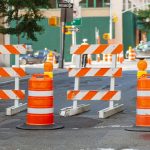Introduction
Definition of Speed bumps & Humps
Speed bumps & Humps are traffic calming devices designed to reduce the speed of vehicles in specific areas. They are typically raised sections of road that force drivers to slow down as they pass over them. The main purpose of Speed bumps & Humps is to enhance safety by preventing excessive speeding and promoting a more controlled flow of traffic. These devices are commonly used in residential areas, school zones, and parking lots where pedestrian safety is a priority. By physically slowing down vehicles, Speed bumps & Humps help to minimize the risk of accidents and create a safer environment for both motorists and pedestrians.
Purpose of Speed bumps & Humps
The purpose of Speed bumps & Humps is to slow down vehicles and improve safety on roads and in parking areas. These traffic calming measures are specifically designed to reduce the speed of vehicles, particularly in areas with high pedestrian activity or where there is a need to control traffic flow. Speed bumps & Humps are effective in forcing drivers to slow down, thereby reducing the risk of accidents, especially in residential areas and near schools. By creating a physical barrier on the road, they encourage drivers to be more cautious and attentive, ultimately ensuring the safety of both pedestrians and motorists.
Importance of studying their effectiveness
The importance of studying the effectiveness of Speed bumps & Humps lies in understanding their impact on road safety and traffic management. By evaluating their effectiveness, we can determine whether they are effectively reducing vehicle speeds and improving road safety. Additionally, studying their effectiveness can help us identify any potential drawbacks or unintended consequences of installing Speed bumps & Humps. This knowledge can then be used to make informed decisions about their implementation and placement, ensuring that they are used in the most effective and efficient way possible.
Design and Construction of Speed bumps & Humps
Types of Speed bumps & Humps
There are several types of Speed bumps & Humps that are commonly used to control vehicle speed. One type is the traditional speed bump, which is a raised section of pavement that forces drivers to slow down as they pass over it. Another type is the speed hump, which is a longer and flatter version of the speed bump. Speed humps are designed to be less jarring to vehicles and provide a smoother ride, while still effectively reducing speed. In addition to these two types, there are also variable height Speed bumps & Humps, which can be adjusted to different heights depending on the desired level of speed control. Overall, the different types of Speed bumps & Humps offer various options for traffic calming and can be strategically placed to enhance road safety.
Materials used in construction
In the construction of Speed bumps & Humps, various materials are used to ensure their effectiveness. One commonly used material is asphalt, which provides a smooth and durable surface for vehicles to drive over. Concrete is also frequently used due to its strength and longevity. Rubber speed bumps are another option, offering a more flexible and cushioned surface that can reduce noise and vibrations. Additionally, some Speed bumps & Humps are made from recycled materials, promoting sustainability and environmental consciousness. The choice of materials depends on factors such as the desired level of traffic calming, budget constraints, and the specific needs of the location.
Factors to consider in design
When designing Speed bumps & Humps, there are several factors that need to be considered. One important factor is the desired speed reduction. The size and shape of the bump or hump should be determined based on the desired speed reduction in order to effectively slow down vehicles. Another factor to consider is the location of the speed bump or hump. It should be strategically placed in areas where speed reduction is necessary, such as near schools or residential areas. Additionally, the materials used in the construction of the speed bump or hump should be durable and able to withstand heavy traffic. Overall, careful consideration of these factors is crucial in designing effective Speed bumps & Humps that promote safer driving and reduce speed-related accidents.
Effects on Vehicle Speed
Reduction of speed
Speed bumps & Humps are effective tools for reducing speed in residential areas and other locations where speeding is a concern. These traffic calming measures are designed to force drivers to slow down, promoting safer driving habits and reducing the risk of accidents. By creating a physical barrier on the road, Speed bumps & Humps require drivers to reduce their speed significantly, making it more difficult to drive at excessive speeds. This reduction in speed not only improves safety for pedestrians and cyclists but also enhances the overall quality of life in the community by discouraging reckless driving and promoting a more peaceful and quiet environment. Additionally, studies have shown that the presence of Speed bumps & Humps can lead to a decrease in traffic volume, as drivers are more likely to seek alternative routes to avoid these obstacles. Overall, the implementation of Speed bumps & Humps is an effective strategy for reducing speed and improving road safety in various settings.
Impact on driver behavior
Speed bumps & Humps have a significant impact on driver behavior. These traffic calming measures are designed to slow down vehicles and encourage safer driving. When drivers approach a speed bump or hump, they are forced to reduce their speed, which in turn increases their awareness of their surroundings. This can help prevent accidents and promote a more cautious driving style. Studies have shown that the presence of Speed bumps & Humps can lead to reduced speeds, decreased traffic volume, and improved compliance with traffic regulations. Overall, the implementation of Speed bumps & Humps has proven to be an effective way to positively influence driver behavior and enhance road safety.
Effectiveness in different road conditions
In different road conditions, Speed bumps & Humps have proven to be effective in reducing vehicle speed and improving road safety. Whether it is on residential streets, school zones, or high traffic areas, these traffic calming measures help to slow down vehicles, preventing accidents and promoting a safer environment for pedestrians and other road users. The effectiveness of Speed bumps & Humps is particularly evident in areas where there are frequent cases of speeding or reckless driving. By introducing these traffic calming measures, authorities can effectively control the speed of vehicles and create a more controlled and secure road environment.
Impact on Traffic Flow
Effect on traffic congestion
Speed bumps & Humps have a significant effect on traffic congestion. These traffic calming measures are designed to slow down vehicles and promote safer driving in residential areas and school zones. By forcing drivers to reduce their speed, Speed bumps & Humps help to prevent accidents and improve overall traffic flow. They also encourage drivers to be more cautious and attentive, reducing the likelihood of reckless driving and congestion. Furthermore, Speed bumps & Humps can help to create a more pedestrian-friendly environment by discouraging speeding and prioritizing the safety of pedestrians and cyclists. Overall, the implementation of Speed bumps & Humps plays a crucial role in reducing traffic congestion and enhancing road safety.
Influence on traffic patterns
Speed bumps & Humps have a significant influence on traffic patterns. These traffic calming measures are designed to slow down vehicles and promote safer driving habits. By introducing obstacles on the road, Speed bumps & Humps force drivers to reduce their speed, preventing excessive acceleration and encouraging a more cautious approach. This, in turn, leads to a smoother flow of traffic and reduces the likelihood of accidents. Furthermore, Speed bumps & Humps can also deter drivers from using certain roads as shortcuts, redirecting traffic to more appropriate routes. Overall, the presence of Speed bumps & Humps positively impacts traffic patterns by enhancing safety and improving the efficiency of the road network.
Considerations for placement
When considering the placement of Speed bumps & Humps, several factors should be taken into account. Firstly, it is important to consider the speed limit of the road. Speed bumps & Humps are most effective on roads with lower speed limits, as they encourage drivers to slow down and adhere to the speed limit. Additionally, the volume of traffic on the road should be considered. Speed bumps & Humps may not be suitable for roads with heavy traffic flow, as they can cause congestion and delays. Furthermore, the proximity of schools, residential areas, and other high pedestrian areas should be considered when deciding where to place Speed bumps & Humps. These areas often require extra caution and measures to ensure the safety of pedestrians. By carefully considering these factors, the placement of Speed bumps & Humps can be optimized to effectively reduce speeding and improve overall road safety.
Safety and Accidents
Reduction of accidents
Speed bumps & Humps are effective tools for reducing accidents on roads. These traffic calming measures force drivers to slow down, ensuring safer driving conditions. By slowing down vehicles, Speed bumps & Humps help to prevent excessive speeding and reckless driving. This reduction in speed significantly decreases the likelihood of accidents, especially in areas with heavy pedestrian traffic or near schools and residential areas. Studies have shown that the presence of Speed bumps & Humps can lead to a significant decrease in both the frequency and severity of accidents. Therefore, implementing Speed bumps & Humps can play a crucial role in promoting road safety and reducing accidents.
Potential risks and hazards
Speed bumps & Humps are effective in reducing vehicle speed and improving road safety. However, they also pose potential risks and hazards to drivers, pedestrians, and cyclists. One of the main concerns is the discomfort and inconvenience caused to drivers, especially those with lower vehicles or medical conditions. The sudden jolt and impact of driving over a speed bump can lead to back and neck injuries. Additionally, speed bumps can cause damage to vehicles, particularly if they are not properly designed or maintained. For pedestrians and cyclists, speed bumps can be a tripping hazard, especially at night when visibility is reduced. It is important for authorities to carefully consider the placement, design, and maintenance of speed bumps to minimize these risks and ensure the overall effectiveness of road safety measures.
Effectiveness in preventing speeding-related accidents
Speed bumps & Humps have proven to be highly effective in preventing speeding-related accidents. These traffic calming measures are designed to slow down vehicles, forcing drivers to reduce their speed. By creating a physical barrier on the road, Speed bumps & Humps create a visual and tactile reminder for drivers to exercise caution and adhere to the speed limit. Studies have shown that the presence of Speed bumps & Humps can significantly reduce the number of accidents caused by excessive speeding. In addition, these measures also help to enhance pedestrian safety by encouraging drivers to be more attentive and aware of their surroundings. Overall, the implementation of Speed bumps & Humps plays a crucial role in promoting safer roads and reducing the risk of speeding-related accidents.
Community Perception and Acceptance
Public opinion on Speed bumps & Humps
Public opinion on Speed bumps & Humps is divided. Some people argue that they are necessary for ensuring road safety, as they force drivers to slow down and reduce their speed. These individuals believe that Speed bumps & Humps are effective in preventing accidents and protecting pedestrians. On the other hand, there are those who view Speed bumps & Humps as a nuisance and unnecessary inconvenience. They argue that these traffic calming measures can damage vehicles and cause discomfort for passengers. Additionally, some argue that Speed bumps & Humps can increase traffic congestion and lead to delays. Overall, public opinion on Speed bumps & Humps varies, with individuals weighing the benefits of road safety against the potential drawbacks and inconveniences they may cause.
Challenges and concerns
Challenges and concerns surrounding the implementation of Speed bumps & Humps have been a topic of discussion among transportation experts and communities alike. One of the main challenges is finding the right balance between traffic calming measures and maintaining smooth traffic flow. While Speed bumps & Humps effectively reduce vehicle speeds, they can also cause discomfort and inconvenience to drivers and passengers. Additionally, there are concerns about the potential damage to vehicles, particularly low-riding or heavily loaded ones. Another concern is the impact on emergency vehicles, as Speed bumps & Humps can slow down response times. Despite these challenges and concerns, Speed bumps & Humps continue to be widely used as an effective tool for controlling speed and promoting road safety.
Strategies for community acceptance
When implementing Speed bumps & Humps in a community, it is important to consider strategies for community acceptance. One effective strategy is to engage with residents and stakeholders early in the decision-making process. This can involve hosting community meetings or surveys to gather feedback and address concerns. Additionally, providing clear communication about the purpose and benefits of Speed bumps & Humps can help alleviate any resistance or opposition. It is also crucial to involve local authorities, such as city councils or neighborhood associations, to ensure that the implementation aligns with community regulations and guidelines. By actively involving the community and addressing their concerns, the acceptance of Speed bumps & Humps can be improved, leading to safer and more pedestrian-friendly neighborhoods.







